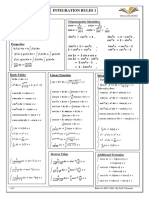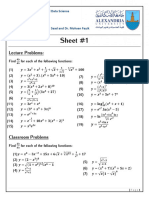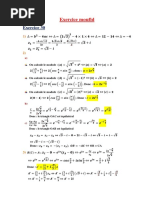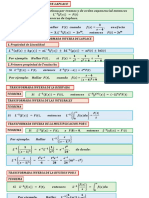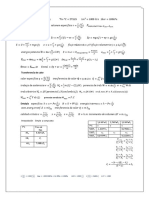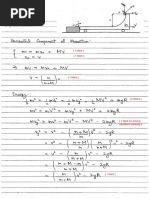Lecture- 15 & 16
Lecture- 15 & 16
Uploaded by
jobaerislam16Copyright:
Available Formats
Lecture- 15 & 16
Lecture- 15 & 16
Uploaded by
jobaerislam16Copyright
Available Formats
Share this document
Did you find this document useful?
Is this content inappropriate?
Copyright:
Available Formats
Lecture- 15 & 16
Lecture- 15 & 16
Uploaded by
jobaerislam16Copyright:
Available Formats
Lecture#15 & 16
Numerical Solution of ODE
Picard’s method:
Initial value problem:
In a n-order differential equation, if the values of dependent variable 𝑦(𝑥) and its first (𝑛 − 1)
order derivatives are specified of a particular point say 𝑥 = 𝑥0 then such a differential equation is
called initial value problem (IVP).
𝒅𝒚
𝑬𝒙 ∶ = 𝟐𝒙 , 𝒘𝒊𝒕𝒉 𝒚(𝟏) = 𝟒
𝒅𝒙
Boundary value problem:
In a n-order differential equation, if the values of dependent variable 𝑦(𝑥) and its first (𝑛 − 1) order
derivatives are specified of at two or more particular points then.
𝒅𝟐 𝒚 𝝅
𝑬𝒙 ∶ + 𝒚 = 𝟎, 𝒚(𝟎) = 𝟏, 𝒚 ( 𝟐 ) = 𝟓
𝒅𝒙𝟐
Picard’s method of successive Approximation:
The n-th approximation is given by ,
𝒙
𝒚(𝒏) = 𝒚𝟎 + ∫ 𝒇(𝒙, 𝒚(𝒏−𝟏) )𝒅𝒙
𝒙𝟎
𝒅𝒚
Problem 1: Using Picard’s method , obtain the solution of = 𝒙 (𝟏 + 𝒙𝟑 𝒚), 𝒚(𝟎) = 𝟑 .
𝒅𝒙
Tabulate the values of 𝒚(𝟎. 𝟏) & 𝒚(𝟎. 𝟐).
Solution: Given,
𝒅𝒚
𝒅𝒙
= 𝒙 (𝟏 + 𝒙𝟑 𝒚)
= 𝒙 + 𝒙𝟒 𝒚
= 𝒇(𝒙, 𝒚)
𝐴𝑛𝑑 𝒚(𝟎) = 𝟑
Here , 𝒙𝟎 = 𝟎, 𝒚𝟎 = 𝟑
We have Picard’s method of successive approximation,
Md. Belal Hossen Numerical Analysis & Coordinate Geometry-(MATH 462)
Assistant Professor, Dept. of CSE
Uttara University
1
Lecture#15 & 16
𝒙
𝒚(𝒏) = 𝒚𝟎 + ∫ 𝒇(𝒙, 𝒚(𝒏−𝟏) )𝒅𝒙
𝒙𝟎
1st Approx.,
𝒙
𝒚(𝟏) = 𝒚𝟎 + ∫ 𝒇(𝒙, 𝒚𝟎 )𝒅𝒙
𝒙𝟎
𝒙
= 𝟑 + ∫𝟎 𝒇(𝒙, 𝟑)𝒅𝒙
𝒙
= 𝟑 + ∫ (𝒙 + 𝟑𝒙𝟒 )𝒅𝒙
𝟎
𝒙𝟐 𝟑 𝟓
𝒚(𝟏) = 𝟑 + + 𝒙
𝟐 𝟓
2nd approx.,
𝒙
(𝟐)
𝒚 = 𝒚𝟎 + ∫ 𝒇(𝒙, 𝒚(𝟏) )𝒅𝒙
𝒙𝟎
𝒙
𝒙𝟐 𝟑 𝟓
= 𝟑 + ∫ 𝒇(𝒙, 𝟑 + + 𝒙 )𝒅𝒙
𝟎 𝟐 𝟓
𝒙 𝒙𝟐 𝟑
= 𝟑 + ∫𝟎 𝒙 + 𝒙𝟒 (𝟑 + 𝟐
+ 𝟓 𝒙𝟓 )𝒅𝒙;
𝒙
𝒙𝟔 𝟑 𝟗
= 𝟑 + ∫ (𝒙 + 𝟑𝒙𝟒 + + 𝒙 )𝒅𝒙
𝟎 𝟐 𝟓
𝒙𝟐 𝟑 𝟓 𝒙𝟕 𝟑 𝟏𝟎
𝒚(𝟐) = 𝟑 + + 𝒙 + + 𝒙
𝟐 𝟓 𝟏𝟒 𝟓𝟎
Thus,
𝒙𝟐 𝟑 𝟓 𝒙𝟕 𝟑 𝟏𝟎
𝒚(𝒙) = 𝟑 + + 𝒙 + + 𝒙
𝟐 𝟓 𝟏𝟒 𝟓𝟎
Now,
(𝟎. 𝟏)𝟐 𝟑 (𝟎. 𝟏)𝟕 𝟑
𝒚 (𝟎. 𝟏) = 𝟑 + + (𝟎. 𝟏)𝟓 + + (𝟎. 𝟏)𝟏𝟎
𝟐 𝟓 𝟏𝟒 𝟓𝟎
Md. Belal Hossen Numerical Analysis & Coordinate Geometry-(MATH 462)
Assistant Professor, Dept. of CSE
Uttara University
2
Lecture#15 & 16
≈ 𝟑. 𝟎𝟎𝟓 (𝒂𝒑𝒑𝒓𝒐𝒙)
(𝟎. 𝟐)𝟐 𝟑 (𝟎. 𝟐)𝟕 𝟑
𝒚 (𝟎. 𝟐) = 𝟑 + + (𝟎. 𝟐)𝟓 + + (𝟎. 𝟐)𝟏𝟎
𝟐 𝟓 𝟏𝟒 𝟓𝟎
≈ 𝟑. 𝟎𝟐𝟎 (𝒂𝒑𝒑𝒓𝒐𝒙)
𝒅𝒚
Problem 2: Solve, using Picard’s method of approximations = 𝟏 − 𝟐𝒙𝒚, 𝒚(𝟎) = 𝟎,
𝒅𝒙
𝑨𝒍𝒔𝒐 𝒚(𝟎. 𝟏), 𝒚(𝟎. 𝟐)
Solution:
Given,
𝒅𝒚
= 𝟏 − 𝟐𝒙𝒚 = 𝒇(𝒙, 𝒚)
𝒅𝒙
𝑎𝑛𝑑 𝒚(𝟎) = 𝟎
𝐻𝑒𝑟𝑒 , 𝒙𝟎 = 𝟎 & 𝒚𝟎 = 𝟎
We have Picard’s method of successive approximation,
𝒙
𝒚(𝒏) = 𝒚𝟎 + ∫ 𝒇(𝒙, 𝒚(𝒏−𝟏) )𝒅𝒙
𝒙𝟎
1st approx.,
𝒙
𝒚(𝟏) = 𝒚𝟎 + ∫ 𝒇(𝒙, 𝒚𝟎 )𝒅𝒙
𝒙𝟎
𝒙
= 𝟎 + ∫ 𝒇(𝒙, 𝟎)𝒅𝒙
𝟎
𝒙
= ∫ (𝟏 − 𝟐𝒙 ∗ 𝟎)𝒅𝒙
𝟎
𝒙
= ∫ (𝟏 − 𝟎)𝒅𝒙
𝟎
𝒙
= ∫ (𝟏)𝒅𝒙
𝟎
=𝒙
Md. Belal Hossen Numerical Analysis & Coordinate Geometry-(MATH 462)
Assistant Professor, Dept. of CSE
Uttara University
3
Lecture#15 & 16
2nd approx.,
𝒙
𝒚(𝟐) = 𝒚𝟎 + ∫ 𝒇(𝒙, 𝒚(𝟏) )𝒅𝒙
𝒙𝟎
𝒙
= 𝟎 + ∫ 𝒇(𝒙, 𝒙)𝒅𝒙
𝟎
𝒙
= ∫ (𝟏 − 𝟐𝒙 ∗ 𝒙)𝒅𝒙
𝟎
𝒙
= ∫ (𝟏 − 𝟐𝒙𝟐 )𝒅𝒙
𝟎
𝟐𝒙𝟑
=𝒙−
𝟑
3rd approx.,
𝒙
𝒚(𝟑) = 𝒚𝟎 + ∫ 𝒇(𝒙, 𝒚(𝟐) )𝒅𝒙
𝒙𝟎
𝒙
𝟐𝒙𝟑
= 𝟎 + ∫ 𝒇 (𝒙, 𝒙 − ) 𝒅𝒙
𝟎 𝟑
𝒙
𝟐𝒙𝟑
= ∫ (𝟏 − 𝟐𝒙 ∗ (𝒙 − )) 𝒅𝒙
𝟎 𝟑
𝒙
𝟒𝒙𝟒
= ∫ (𝟏 − 𝟐𝒙𝟐 + ) 𝒅𝒙
𝟎 𝟑
𝟐𝒙𝟑 𝟒𝒙𝟓
=𝒙− +
𝟑 𝟏𝟓
Thus,
𝟐𝒙𝟑 𝟒𝒙𝟓
𝒚(𝒙) = 𝒙 − + .
𝟑 𝟏𝟓
𝟐(𝟎. 𝟏)𝟑 𝟒(𝟎. 𝟏)𝟓
𝑵𝒐𝒘 , 𝒚(𝟎. 𝟏) = (𝟎. 𝟏) − +
𝟑 𝟏𝟓
≈ 𝟎. 𝟎𝟗𝟗𝟑𝟒 (𝒂𝒑𝒑𝒓𝒐𝒙)
𝟐(𝟎. 𝟐)𝟑 𝟒(𝟎. 𝟐)𝟓
𝑨𝒏𝒅 , 𝒚(𝟎. 𝟐) = (𝟎. 𝟐) − +
𝟑 𝟏𝟓
Md. Belal Hossen Numerical Analysis & Coordinate Geometry-(MATH 462)
Assistant Professor, Dept. of CSE
Uttara University
4
Lecture#15 & 16
≈ 𝟎. 𝟏𝟗𝟒𝟔𝟕 (𝒂𝒑𝒑𝒓𝒐𝒙)
Answer : 𝒚(𝟎. 𝟏) ≈ 𝟎. 𝟎𝟗𝟗𝟑𝟒 (𝒂𝒑𝒑𝒓𝒐𝒙) and 𝒚(𝟎. 𝟐) ≈ 𝟎. 𝟏𝟗𝟒𝟔𝟕(𝒂𝒑𝒑𝒓𝒐𝒙)
𝒅𝒚
3. Solve the differential equation 𝒅𝒙
= 𝒙 + 𝒚𝟐 , 𝒚(𝟎) = 𝟏 𝒖𝒑 𝒕𝒐 𝒔𝒆𝒄𝒐𝒏𝒅 𝒂𝒑𝒑𝒓𝒐𝒙𝒊𝒎𝒂𝒕𝒊𝒐𝒏 by
Picard’s method
Solution: Given,
𝒅𝒚
𝒅𝒙
= 𝒙 + 𝒚𝟐 = 𝒇(𝒙, 𝒚) 𝒂𝒏𝒅 𝒚(𝟎) = 𝟏
𝑯𝒆𝒓𝒆, 𝒙𝟎 = 𝟎, 𝒚𝟎 = 𝟏
We have Picard’s method of successive approximation.
𝒙
𝒚 (𝒏)
= 𝒚𝟎 + ∫ 𝒇(𝒙, 𝒚(𝒏−𝟏) )𝒅𝒙
𝒙𝟎
1st approx.,
𝒙
𝒚(𝟏) = 𝒚𝟎 + ∫ 𝒇(𝒙, 𝒚𝟎 )𝒅𝒙
𝒙𝟎
𝒙
= 𝟏 + ∫ 𝒇(𝒙, 𝟏)𝒅𝒙
𝟎
𝒙
= 𝟏 + ∫ 𝒇(𝒙 + 𝟏𝟐 )𝒅𝒙
𝟎
𝒙
= 𝟏 + ∫ (𝒙 + 𝟏)𝒅𝒙
𝟎
𝒙𝟐
=𝟏+ +𝒙
𝟐
𝒙𝟐
=𝟏+𝒙+
𝟐
2nd approx.,
𝒙
𝒚(𝟐) = 𝒚𝟎 + ∫ 𝒇(𝒙, 𝒚(𝟏) )𝒅𝒙
𝒙𝟎
𝒙
𝒙𝟐
= 𝟏 + ∫ 𝒇 (𝒙, 𝟏 + 𝒙 + ) 𝒅𝒙
𝟎 𝟐
Md. Belal Hossen Numerical Analysis & Coordinate Geometry-(MATH 462)
Assistant Professor, Dept. of CSE
Uttara University
5
Lecture#15 & 16
𝒙 𝟐
𝒙𝟐
= 𝟏 + ∫ {𝒙 + (𝟏 + + 𝒙) } 𝒅𝒙
𝟎 𝟐
𝒙
𝒙𝟒 𝒙𝟐 𝒙𝟐
= 𝟏 + ∫ {𝒙 + (𝟏 + 𝒙𝟐 + + 𝟐. 𝒙. 𝟏 + 𝟐. 𝒙. + 𝟐. . 𝟏)} 𝒅𝒙
𝟎 𝟒 𝟐 𝟐
𝒙
𝒙𝟒 𝒙𝟐 𝒙𝟐
= 𝟏 + ∫ (𝒙 + (𝟏 + 𝒙𝟐 + + 𝟐. 𝒙. 𝟏 + 𝟐. 𝒙. + 𝟐. . 𝟏)𝒅𝒙
𝟎 𝟒 𝟐 𝟐
𝒙
𝒙𝟒
= 𝟏 + ∫ (𝟏 + 𝟑𝒙 + 𝟐𝒙𝟐 + 𝒙𝟑 + ) 𝒅𝒙
𝟎 𝟒
𝒙𝟐 𝒙𝟑 𝒙𝟒 𝒙𝟓
= 𝟏 + 𝒙 + 𝟑. 𝟐
+𝟐 𝟑
+ 𝟒
+ 𝟐𝟎 (ans.)
H.W. Problem:
𝑑𝑦
1. Use Picard method for the solution of 𝑑𝑥 = 𝑥 + 𝑦, 𝑥0 = 0, 𝑦0 = 1 and obtain the values of 𝑦1 ,𝑦2 , 𝑦3
corresponding to 𝑥 = 0.1,0.2,0.3 respectively. The values should be correct up to four decimal places.
2. Find an approximate solution of the initial value problem 𝑦 ′ = 1 + 𝑦 2 , 𝑦(0) = 0 by Picard’s method.
Md. Belal Hossen Numerical Analysis & Coordinate Geometry-(MATH 462)
Assistant Professor, Dept. of CSE
Uttara University
6
You might also like
- IRH ProjectDocument19 pagesIRH ProjectIvan Sanchez100% (2)
- The Voice of The MountainDocument7 pagesThe Voice of The MountainHimank Saklecha80% (5)
- A Reflection Paper On The Song "Meme Na Mindanaw"Document1 pageA Reflection Paper On The Song "Meme Na Mindanaw"Maeven E. Tubayan0% (1)
- DR Lara Abou Orm Calculus III Hyperbolic Functions, Inverse Trigonometric Functions, SeriesDocument4 pagesDR Lara Abou Orm Calculus III Hyperbolic Functions, Inverse Trigonometric Functions, SeriesIsmael hijaziNo ratings yet
- قواعد التكامل PDFDocument4 pagesقواعد التكامل PDFريانNo ratings yet
- De5 1Document1 pageDe5 1Shara ZeynNo ratings yet
- l 02 IntegrationDocument40 pagesl 02 Integrationhk7116478No ratings yet
- Solved Prelium Paper XII-B 2024Document4 pagesSolved Prelium Paper XII-B 2024farzana.2753No ratings yet
- Separable and Exact Equations FinalsDocument13 pagesSeparable and Exact Equations FinalsOh Dee PeiNo ratings yet
- Free Convection PDFDocument9 pagesFree Convection PDFaditya a pNo ratings yet
- Model with dist. delayDocument2 pagesModel with dist. delaychokriNo ratings yet
- 7 IntegrationDocument7 pages7 Integrationأيوب عبد الأمير هزبر /تقنية غازNo ratings yet
- Formulario Series de FourierDocument2 pagesFormulario Series de FourierItzan Charbel Flores BravoNo ratings yet
- Laporan Praktikum Pengendalian Dan Instrumentasi ProsesDocument5 pagesLaporan Praktikum Pengendalian Dan Instrumentasi ProsesDeborah Basa LumbanrajaNo ratings yet
- Lecture-09 Line Integration Conservative Field StudentDocument7 pagesLecture-09 Line Integration Conservative Field Studentarnabnghs2004No ratings yet
- Formula Sheet: Types of MaterialDocument3 pagesFormula Sheet: Types of MaterialdaraNo ratings yet
- Correc Exe1Document1 pageCorrec Exe1SOUFIANE BOURCHIHNo ratings yet
- The First Fundamental Theorem of Calculus Second Fundamental Theorem of CalculusDocument7 pagesThe First Fundamental Theorem of Calculus Second Fundamental Theorem of Calculuskierby sanbagrielNo ratings yet
- Hyperbolic FunctionsDocument23 pagesHyperbolic FunctionsPaula FanaNo ratings yet
- Numerical - Method-PPT Final 1Document92 pagesNumerical - Method-PPT Final 1Md.Hasibur RahmanNo ratings yet
- Formulario N 1 (Algebra)Document1 pageFormulario N 1 (Algebra)Moises Mamani BarcoNo ratings yet
- Calculus (Sheets)Document28 pagesCalculus (Sheets)shahd.akram13No ratings yet
- 𝑊 (𝐹⃗) = F ⃗⃗ × AB ⃗⃗⃗⃗⃗⃗ 𝑊 (𝐹⃗) = F. AB. cos αDocument4 pages𝑊 (𝐹⃗) = F ⃗⃗ × AB ⃗⃗⃗⃗⃗⃗ 𝑊 (𝐹⃗) = F. AB. cos αdrissboum1bacNo ratings yet
- Formative Exam Spring 24 Model AnswerDocument2 pagesFormative Exam Spring 24 Model AnswerAbdalrhman MahmoudNo ratings yet
- Exercice MoufidDocument2 pagesExercice MoufidTEST - TESTNo ratings yet
- 1.2 - Literal Equations & Linear ApplicationsDocument7 pages1.2 - Literal Equations & Linear ApplicationsRishabh NagdaNo ratings yet
- Ejercicios Resolver Los Siguientes Ejercicios. 1Document2 pagesEjercicios Resolver Los Siguientes Ejercicios. 1ManuelMaciasNo ratings yet
- Tipo de Resalto en Base A F3Document2 pagesTipo de Resalto en Base A F3MarinaNo ratings yet
- Lecture-015 Stokes Theorem Class Lecture StudentDocument13 pagesLecture-015 Stokes Theorem Class Lecture Studentarnabnghs2004No ratings yet
- Exercise 5.7-Chemical Reaction EngineeringDocument2 pagesExercise 5.7-Chemical Reaction EngineeringCharles Arthel ReyNo ratings yet
- 5.a Input and Transfer ImpedanceDocument6 pages5.a Input and Transfer ImpedanceSaravanan ManavalanNo ratings yet
- Deduciion GibbsDocument3 pagesDeduciion GibbsKaren Gabriela RoldánNo ratings yet
- Bab. IntegralDocument9 pagesBab. IntegralArkan AufaNo ratings yet
- Remember Basic Closed Loop Amplifier: An Op-Amp With Negative Feedback (A Non-Inverting Amplifier)Document3 pagesRemember Basic Closed Loop Amplifier: An Op-Amp With Negative Feedback (A Non-Inverting Amplifier)ruukiNo ratings yet
- ElectronicsDocument57 pagesElectronicsYashodha SNo ratings yet
- Calculus S7 V3Document12 pagesCalculus S7 V3نجوي حامد امبابيNo ratings yet
- Practice 14.2Document5 pagesPractice 14.2khalidNo ratings yet
- RMM Calculus Marathon 1501 1600 CompressedDocument152 pagesRMM Calculus Marathon 1501 1600 CompressedsyedshahabudeenNo ratings yet
- Clase 11 - Mat IV - Transformada de LaplaceDocument9 pagesClase 11 - Mat IV - Transformada de LaplaceYAN ELIO MANRIQUE MOGOLLONNo ratings yet
- Non-Linear PDEsDocument9 pagesNon-Linear PDEsPrakritish GhoshNo ratings yet
- Formulario Undad 3Document5 pagesFormulario Undad 3SERGIO FALCON CASIANONo ratings yet
- Parametric Equations by Chain RuleDocument10 pagesParametric Equations by Chain RuleSyedda Kashf GilaniNo ratings yet
- Ravi Sir 7.2-FDocument7 pagesRavi Sir 7.2-FQUANTUMLING BUDDHANo ratings yet
- Beta Gamma TheoryDocument4 pagesBeta Gamma TheoryShivam GuptaNo ratings yet
- Flow in PipesDocument35 pagesFlow in Pipesgugusomtunzi60No ratings yet
- 10 Higuera Corrosion y TransporteDocument49 pages10 Higuera Corrosion y TransporteEduardo SorcererNo ratings yet
- Chain Rule For Several Independent VariablesDocument3 pagesChain Rule For Several Independent Variablesmalikabdulah425No ratings yet
- Formulas TermodinamicasDocument1 pageFormulas TermodinamicasEdgar AgusNo ratings yet
- Vector AnalysisDocument2 pagesVector AnalysismylimbofriendNo ratings yet
- REVISIONDocument8 pagesREVISIONBún CáNo ratings yet
- Sesiones 27-28:: Análisis Vectorial y Tensorial Aplicado A La FísicaDocument22 pagesSesiones 27-28:: Análisis Vectorial y Tensorial Aplicado A La FísicaLev LandauNo ratings yet
- 01 Time Domain SpecificationDocument26 pages01 Time Domain SpecificationShadowツNo ratings yet
- Inverse Laplace Transform ModuleDocument18 pagesInverse Laplace Transform ModuleAditya SinghNo ratings yet
- Domain and Range, Intercepts, Asymptotes of Rational FunctionDocument20 pagesDomain and Range, Intercepts, Asymptotes of Rational Functiongeorgelescano007No ratings yet
- Formulario MTBF Calcular La Probabilidad de Falla Estadística Por: . + .Document3 pagesFormulario MTBF Calcular La Probabilidad de Falla Estadística Por: . + .Eduardo Torres PinoNo ratings yet
- 200 Solved Problem in Integration by Adel YoussefDocument111 pages200 Solved Problem in Integration by Adel Youssefjuliansantiagofuentes7No ratings yet
- A-level Maths Revision: Cheeky Revision ShortcutsFrom EverandA-level Maths Revision: Cheeky Revision ShortcutsRating: 3.5 out of 5 stars3.5/5 (8)
- Trigonometric Ratios to Transformations (Trigonometry) Mathematics E-Book For Public ExamsFrom EverandTrigonometric Ratios to Transformations (Trigonometry) Mathematics E-Book For Public ExamsRating: 5 out of 5 stars5/5 (1)
- De Moiver's Theorem (Trigonometry) Mathematics Question BankFrom EverandDe Moiver's Theorem (Trigonometry) Mathematics Question BankNo ratings yet
- Lecture- 21 & 22Document12 pagesLecture- 21 & 22jobaerislam16No ratings yet
- SW_Lecture-08.pptxDocument44 pagesSW_Lecture-08.pptxjobaerislam16No ratings yet
- Lecture 3 AgileDocument47 pagesLecture 3 Agilejobaerislam16No ratings yet
- Lecture 2 - SDLC ModelsDocument24 pagesLecture 2 - SDLC Modelsjobaerislam16No ratings yet
- Stock Market Analysis Using Supervised Machine LearningDocument4 pagesStock Market Analysis Using Supervised Machine Learningdeshmukhneha833No ratings yet
- Abdulrahman Bakri: ProfileDocument2 pagesAbdulrahman Bakri: ProfileM3dn aNo ratings yet
- The Ten Basic Pricing StrategiesDocument21 pagesThe Ten Basic Pricing StrategiesZara ImranNo ratings yet
- Acupuncture in Modern MedicineDocument400 pagesAcupuncture in Modern Medicinepranav100% (3)
- T 1Document300 pagesT 1Dinesh V KumarNo ratings yet
- 05-Adaptive Resonance TheoryDocument0 pages05-Adaptive Resonance TheoryCHANDRA BHUSHANNo ratings yet
- Festo AirJelly - EnglishDocument4 pagesFesto AirJelly - Englishairshipworld100% (3)
- Princess SeptemberDocument2 pagesPrincess SeptemberSatish Kumar100% (1)
- InflorescenceDocument26 pagesInflorescencesourov546vermaNo ratings yet
- Street PerformerDocument6 pagesStreet PerformerKitsu NayNo ratings yet
- 02 Biology Viva Questions 2023-24 B South FinalDocument2 pages02 Biology Viva Questions 2023-24 B South Finalvarshithajadhav6No ratings yet
- Toyota TroubleshootingDocument5 pagesToyota TroubleshootingAmanda ThompsonNo ratings yet
- British L129A1 Sharpshooter RifleDocument3 pagesBritish L129A1 Sharpshooter RiflehxntaiforredditNo ratings yet
- APhO Team Selection Test 3 MarkingDocument13 pagesAPhO Team Selection Test 3 MarkingMarcus PoonNo ratings yet
- Workshop Manual XJ 900Document48 pagesWorkshop Manual XJ 900Armando BarrancoNo ratings yet
- Reclamation Methods PDFDocument3 pagesReclamation Methods PDFmghsecsNo ratings yet
- A Set of Measures of Centrality Based On BetweennessDocument8 pagesA Set of Measures of Centrality Based On Betweennessbruna_fonsecaNo ratings yet
- Mineral Analysis of Averrhoa Bilimbi L. - A Potential Fruit: January 2014Document3 pagesMineral Analysis of Averrhoa Bilimbi L. - A Potential Fruit: January 2014veronica francisNo ratings yet
- Betting Track2 21 AdvancedDocument74 pagesBetting Track2 21 AdvancedNanaKarikariMintahNo ratings yet
- 2B. Unit 7: A. Complete The Sentences With Forms of Transport. (12 Puntos)Document3 pages2B. Unit 7: A. Complete The Sentences With Forms of Transport. (12 Puntos)Anonymous QSotSVNo ratings yet
- 36 Circular 2024Document2 pages36 Circular 2024majhirabindramohanNo ratings yet
- Gap Analysis Deadline: May 26Document3 pagesGap Analysis Deadline: May 26Karla Therese Licos100% (3)
- Artificial Intelligence Answer KeyDocument1 pageArtificial Intelligence Answer KeycookecNo ratings yet
- Lecture2 Chapter4 - BCD To Excess-3 Code Converter DesignDocument19 pagesLecture2 Chapter4 - BCD To Excess-3 Code Converter DesignAyesha HussainNo ratings yet
- Project Report On A SMALL SCALE INDUSTRYDocument26 pagesProject Report On A SMALL SCALE INDUSTRYSonu SankhyanNo ratings yet
- Uaap Ncaa ArchivesDocument14 pagesUaap Ncaa ArchivesmackyferdieNo ratings yet
- Reading Recovery Logic ModelDocument1 pageReading Recovery Logic Modelapi-365594287No ratings yet
- TAT TestDocument5 pagesTAT TestIrsa ZaheerNo ratings yet




